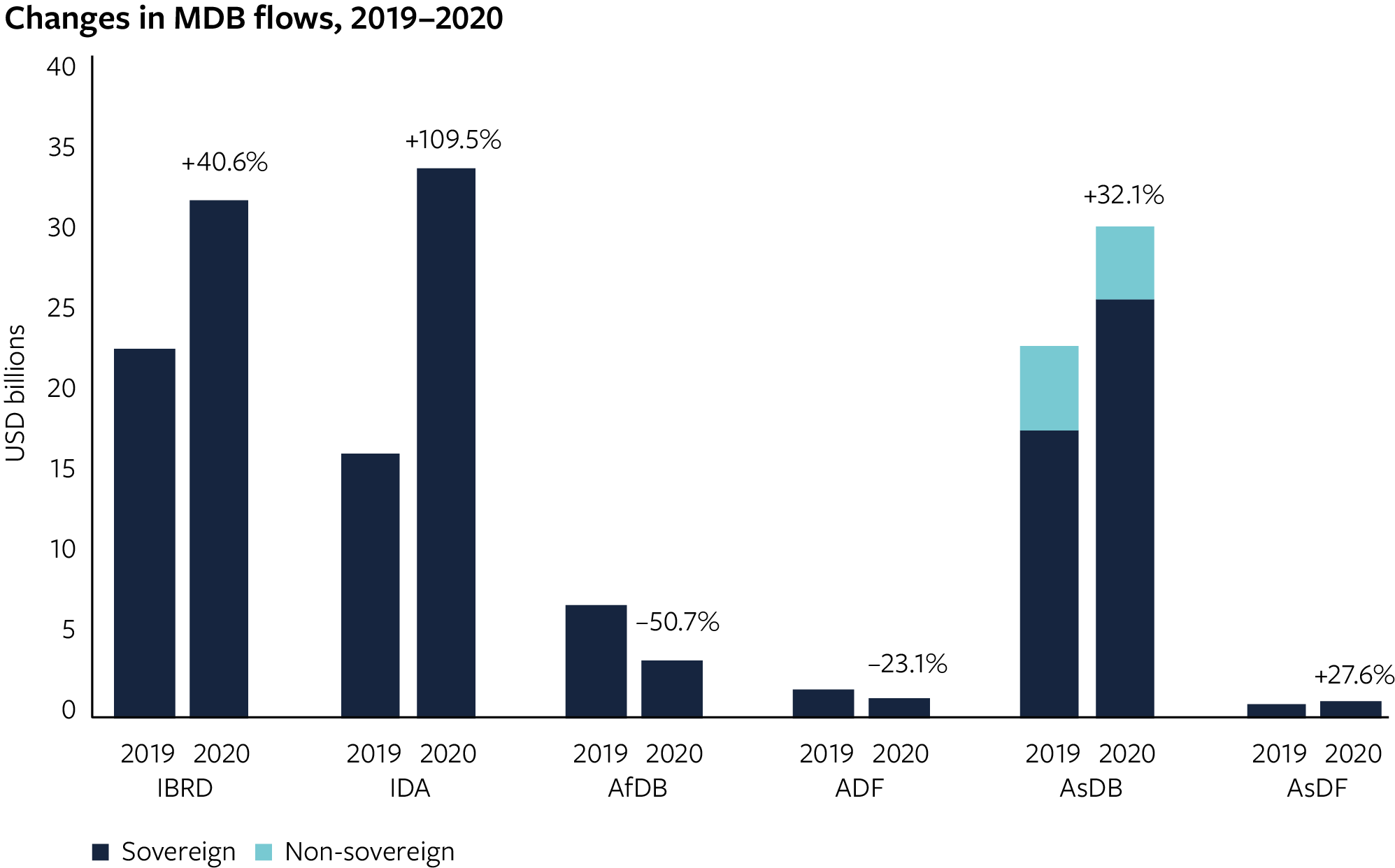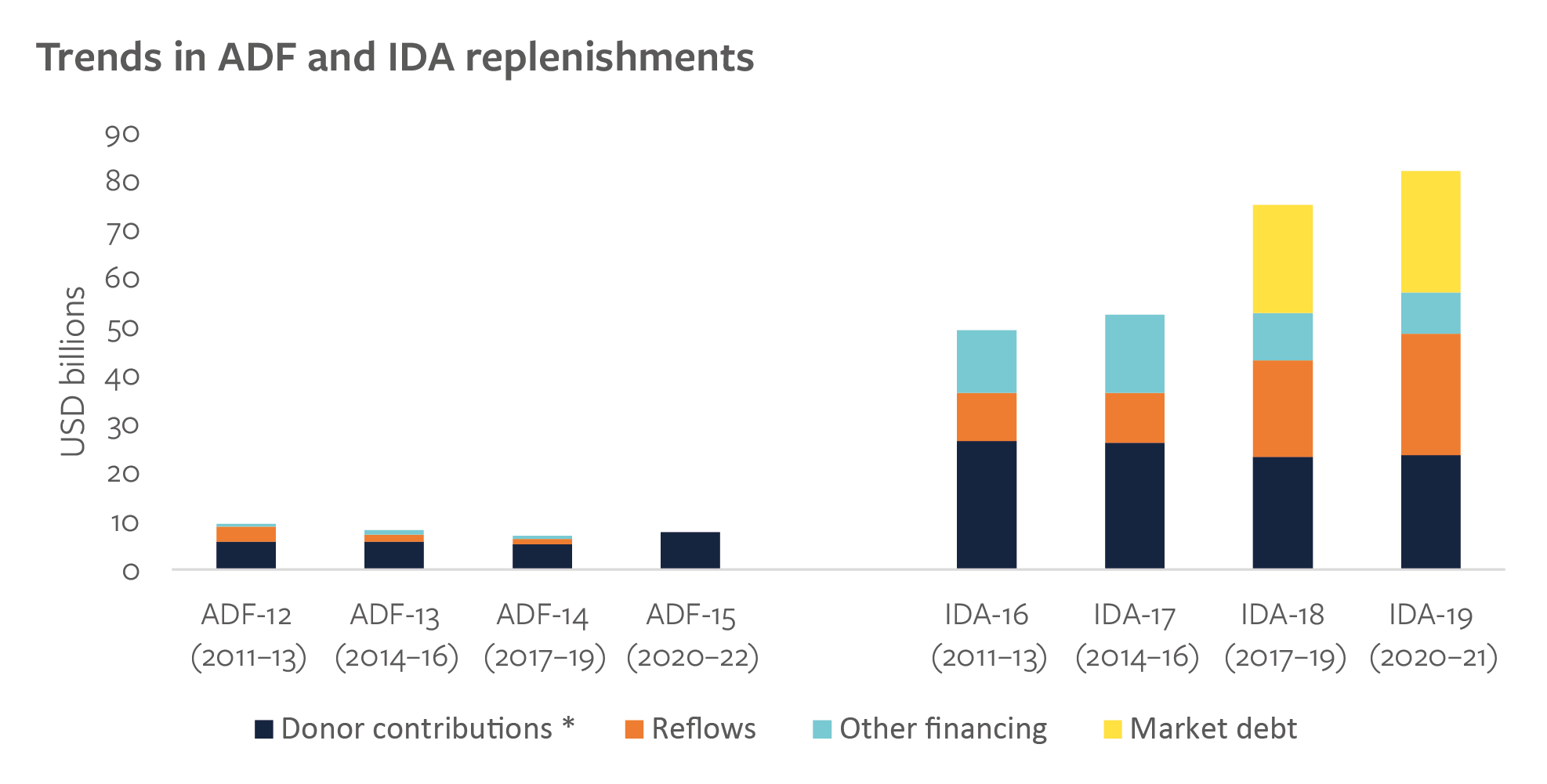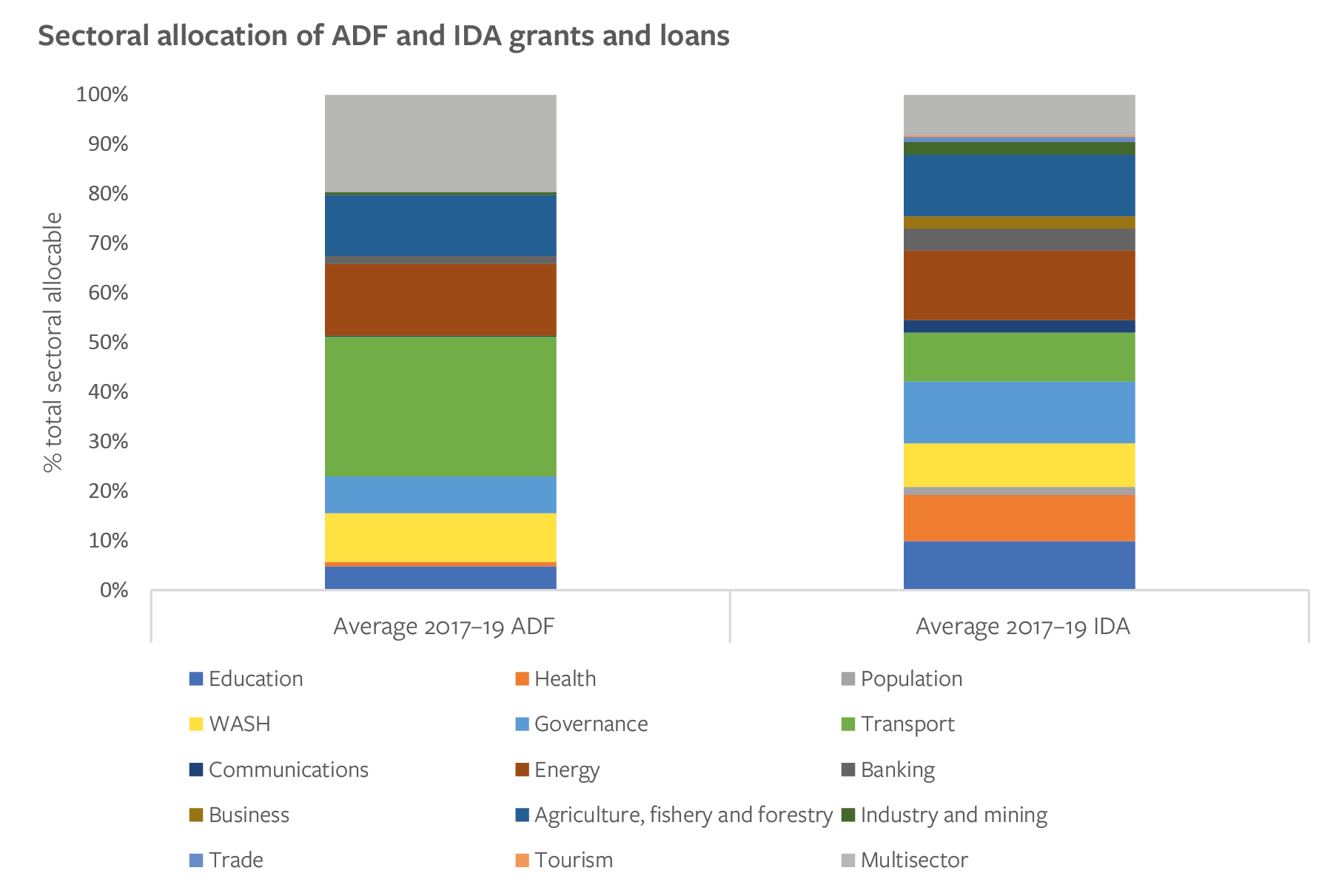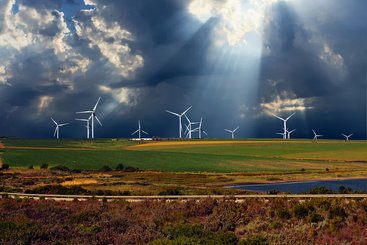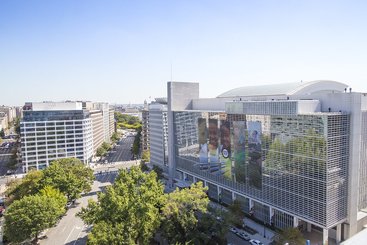Introduction
The overall multilateral response to the Covid-19 crisis has been underwhelming when juxtaposed with the fiscal responses of G20 countries and an ambitious ‘build back better’ mantra in global development agendas. A rise in international public finance of less than $100 billion in 2020 to help low- and middle-income countries tackle the Covid-19 crisis is a drop in the ocean compared to the unprecedented $13.7 trillion fiscal packages in G20 countries, equivalent to less than 1% of the latter.
The international public finance response relied on multilateral institutions, and shareholders have supported these institutions despite pressure on public budgets so far. In 2020 bilateral donors spent only $8.4 billion more than in 2019, a 3.5% year-on-year growth [PDF]. More than 90% of the additional international public finance in 2020 had been mobilised by multilateral development banks (MDBs) and the International Monetary Fund (IMF). The IMF increased its net lending by $44 billion in 2020, nearly equivalent to the rise in operations of all the global and regional MDBs combined in the same year. This is no big surprise: emergency lending and counter-cyclical finance should be the bread and butter of the IMF and the MDBs. And, all in all, government shareholders do value multilateral channels. Even with flat donor contributions overall, the replenishment of IDA20 in 2021 was its largest ever. It has even been brought forward by a year to prevent credits and grants to International Development Association (IDA) eligible countries from falling from mid-2022. The International Fund for Agricultural Development (IFAD) received its highest replenishment ever in 2020.
The replenishment of the African Development Fund (ADF), ADF-16, is the next in line to be negotiated in 2022. Here I argue why and how its contributing shareholders should invest in it, as much as they did for IDA and IFAD, to support African economies in their recovery from the Covid-19 crisis.
Why support the replenishment of the ADF?
Primarily, sub-Saharan Africa (SSA) countries need financial support for the recovery from the Covid-19 crisis. The region is set to grow by 3.7% in 2021 and 3.8% in 2022 according to the IMF. However, recovery is expected to be slower than in the rest of the world, accelerating the divergence in income per capita with advanced economies that began well before the Covid-19 crisis. The Regional Economic Outlook for sub-Saharan Africa in October 2021 couldn’t have put it more clearly: ‘without external financial and technical assistance, the divergent recovery paths of sub-Saharan Africa and the rest of the world may harden into permanent fault lines, jeopardizing decades of hard-won progress’. The asks for the IDA20 were backed up by an analysis suggesting that IDA countries – half of them in SSA – would need additional external financing of more than $800 billion between 2022 and 2025 to return to economic convergence with advanced economies. With an IDA20 replenishment round of $93.5 billion that was below what African governments asked for ($100 billion), SSA countries will need an ambitious ADF-16 replenishment round to get closer to the additional financing needed.
Furthermore, the ADF did not manage to contribute to the growing needs of its regional members and to expand its project approvals in the first phase of the Covid-19 crisis. The African Development Bank (AfDB) was the only MDB that didn’t approve a greater volume of projects in 2020 compared to 2019 (both concessional and non-concessional operations) and turned out to be pro-cyclical rather than countercyclical: project approvals fell by 23% for the ADF (Figure 1). On the contrary, overall IDA project approvals more than doubled between 2019 and 2020 and grew by 35% in SSA countries (excluding large-scale new funding to Nigeria for more than $4.5 billion). In more granular terms, the volume of projects approved and funded by IDA grew in 22 out of 39 SSA countries in 2020 compared to 2019. That was the case for only 15 countries under the ADF.
Figure 1
What are the constraints on the ADF?
First, the overall envelope of recent ADF replenishments has gone up but at a far slower pace than at IDA, and its size remains quite small compared to the latter, despite half of IDA countries being ADF beneficiaries too. The total envelope of the IDA replenishments rose by more than 55% between IDA17 and IDA19. ADF-15 grew by 32%, reversing a downward path in the previous replenishment (AfDB, 2019 annual report). Much of the increase in IDA18 and IDA19 was due to reflows of previous loans and its hybrid model, as IDA can use its equity to float bonds in the international capital markets (and the ADF cannot at the moment; more below). A greater share of ADF countries rely on grant financing, which means reflows are much smaller than in IDA. The hybrid IDA model leverages $3 of $1 contributed by donors – and up to nearly $4 more recently – and reduced donor financial injections over time. But donor contributions to IDA are still at least three times bigger than to the ADF (Figure 2). Ultimately, the ADF is much smaller than IDA limiting how the ADF can respond to crises with countercyclical funding.
Figure 2
The AfDB as a group is one of the ‘most effective’ and cost-effective MDBs (see the review by ICAI in 2020, for example). The ADF also ranks second among all the 49 bilateral and multilateral institutions surveyed by the Center for Global Development (CGD) in its Quality of ODA index (QuODA). This elevated ranking is the result of a high share of its project and programme funding spent in-country; a focus on poverty and countries that receive less aid from other donors; and alignment with the objectives of the beneficiary government. As with the World Bank, the AfDB is in the top quartile of all three multilateral aid reviews [PDF] (MOPAN, UK, the Netherlands). The share of ADF non-performing loans (2.1% [PDF] in 2019) is only slightly higher than for IDA (1.6% in 2019). But despite these positive indicators of operational effectiveness, the reality is that non-regional donors challenge the effectiveness of the institution and prioritise IDA over the ADF. This is also partly explained by the constrained ability of creditors to influence and exercise control in the AfDB compared to other MDBs.
Second, the type of projects the ADF concentrates on can require a longer lead time for design and approval. In the three years before the crisis, projects and programmes in the transport and energy sectors were more than half of the ADF portfolio, but about one quarter for IDA (Figure 3). IDA had been much faster in adapting to the Covid-19 programmes too, focusing on the emergency response in the social sectors, including on health systems and vaccine financing. The smaller number of projects approved by the ADF can also be justified by the greater proportion of regional projects that slowed down as a result of the pandemic. For example, between 2017 and 2019 on average 18% of ADF disbursements were not allocated to a single country, compared to about 0.5% for IDA, based on Organisation for Economic Co-operation and Development (OECD) data. At the onset of the pandemic, the ADF substantially scaled up fast-disbursing crisis response budget support operations, but precise estimates and uptake are unavailable beyond an early evaluation.
Figure 3
Third, project preparation remains a critical area for the AfDB. In 2018 an Independent Development Evaluation (IDEV) [PDF] report stressed how ‘deficits in the management of project preparation [have] contributed to nearly half of all projects being approved in the fourth quarter of each year’. Recommendations include measures to improve the efficiency and effectiveness of quality review processes as well as greater use of project preparation facilities to increase project quality from the outset. The AfDB has long-standing staff shortages in key areas like environmental and social safeguards and operations in fragile countries.
Finally, in 2021 half of the economies in SSA (accounting for 25% of the region’s GDP and 28% of the region’s debt stock) were either in debt distress or at high risk of debt distress. Only one country in the region [PDF] (Tanzania) was classified as being at low risk of debt distress, although the assessment has not been updated since the start of the Covid-19 crisis. A deteriorating public debt situation might disincentivise countries at low or moderate risk of debt distress from borrowing, as loans are the only or the main option available to them. This effect could be amplified should the ADF align with the new IDA proposal of a full allocation in the form of loans – instead of half loans, half grants – for countries at moderate risk of debt distress. More importantly, deteriorating public debt profiles mean a higher proportion of grants in country allocations, which would consume resources even more quickly. On top of this, the ADF has a far greater concentration risk than IDA (with fewer borrowing countries) and a greater proportion of fragile countries in its portfolio (more than half of the countries in the ADF compared to just above 40% in IDA).
What are the options for the next ADF replenishment round? Donor contributions and a stronger sectoral focus
In 2022 many governments will have limited capacity to spend more on development cooperation, as their economies will very likely still be battling with the social and economic effects of the Covid-19 pandemic. Other replenishment rounds are also taking place in the same year and on critical issues like vaccine development and distribution (e.g. CEPI, GFATM), increasing competition for public funding even further.
Donor contributions will still be the pillar of the ADF replenishment. A few options for reform to reduce the burden on donor contributions have been put on the table, ranging from the merger of the two windows of the AfDB Group, leveraging equity from the ADF, and the rechannelling of Special Drawing Rights (SDRs). But these reforms cannot be considered even a partial substitute to an increase in donor contributions next year. The effects of these reforms won’t materialise in the next couple of years – when resources will be most needed – even if they are found to be both technically and politically feasible.
Options for reform try to replicate what other MDBs have done recently, e.g. a merger of the concessional and non-concessional windows, much as the Asian Development Bank (AsDB) did in 2015, or to leverage equity from the ADF like IDA did in 2018. An AfDB and ADF merger could potentially double the size of the group’s lending programme over the medium term, as estimated by Clemence Landers and Nancy Lee in this excellent commentary back in 2019. However, the merger of the AsDB reflected an institution whose members were increasingly moving away from concessional assistance. The number of borrowers at concessional terms at the ADF is still much larger than the AfDB at non-concessional terms: 38 eligible countries for ADF out of 54 regional countries as of February 2018. And this is on top of any legal reforms of the articles of agreements and voting shares that might be required to merge the two windows of the AfDB group. Leveraging equity from ADF is an option but IDA has enjoyed a far stronger reputation with investors and rating agencies, lower concentration risk and far greater equity (ADF has less than a tenth of IDA’s [PDF]).
Rechannelling SDRs to the ADF presents technical and legal hurdles too; ensuring SDRs retain their reserve status might be easier if they are lent or pledged as contributions to general capital increases in non-concessional windows, rather than being a contribution to funds that are based on regular replenishments. On-lending of SDRs would require keeping the same liquidity characteristics, mitigating risks for longer maturities of the ADF’s commitments, and paying any differential between the SDR interest rate and the one prevailing at the MDB.
The ADF leveraging its strengths to complement other MDBs in the region would make a compelling argument for rising donor contributions. The ADF should have a very strong focus on its strengths – such as transport, telecommunications, agriculture, energy and the digital economy – which are in high demand among its member countries (see here on agriculture, with more to come from the results of our project on why client countries value MDBs and where they see their role evolve). Investing in infrastructure development will be key to support the economic convergence of African economies with advanced economies, especially as infrastructure financing may have suffered since the beginning of the pandemic, for which the health response and social protection measures had been prioritised. The ADF should also continue to keep regional economic integration as one of its core functions and should scale up its regional window. In this way, the ADF can complement the sectors where IDA operates, the latter increasingly shifting towards the social sector and pandemic preparedness.
The ADF client countries count among those that will take longer to recover from the Covid-19 crisis; the financing needs in the region have risen and, for many African economies, grants and concessional credits from MDBs (especially from the ADF) have been falling. I have previously argued that investing in MDBs is good value for money for shareholders compared to bilateral programmes – including in the concessional windows largely funded by donor contributions. We have seen how several shareholders (but not all) have stepped up their game for the IDA20 replenishment. They should do the same for the ADF too: there is no time to rest on our laurels.
